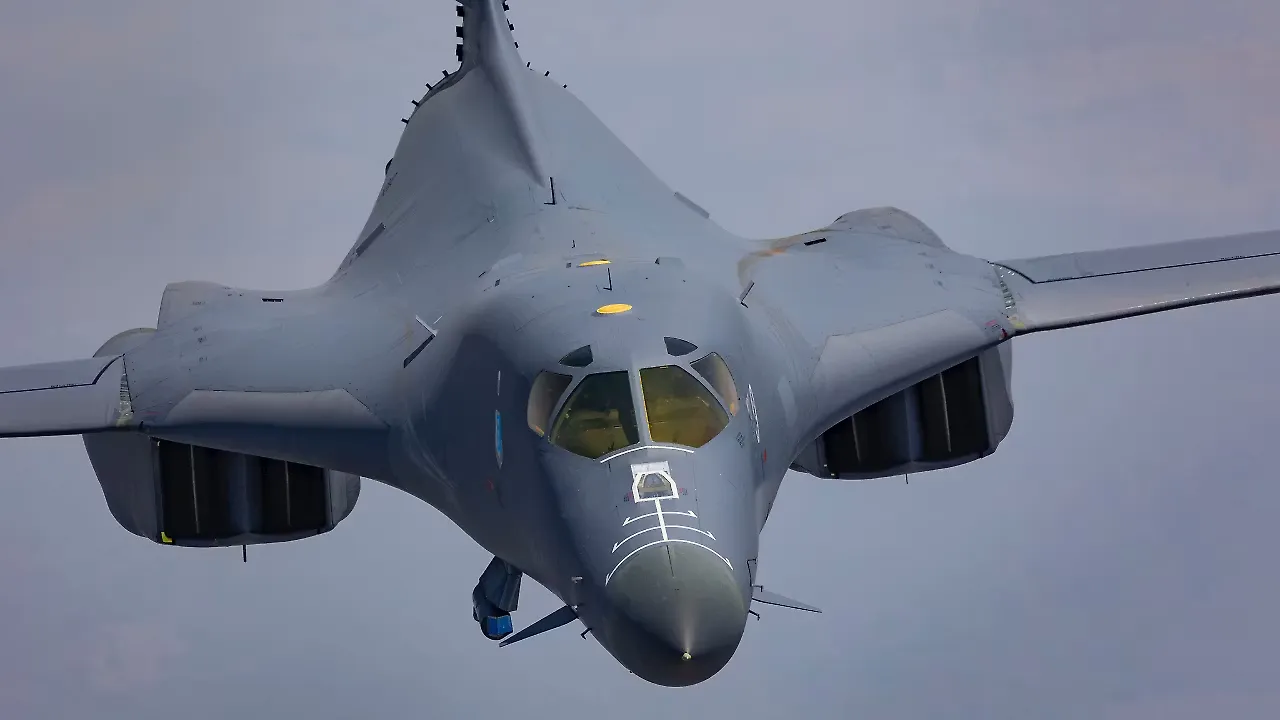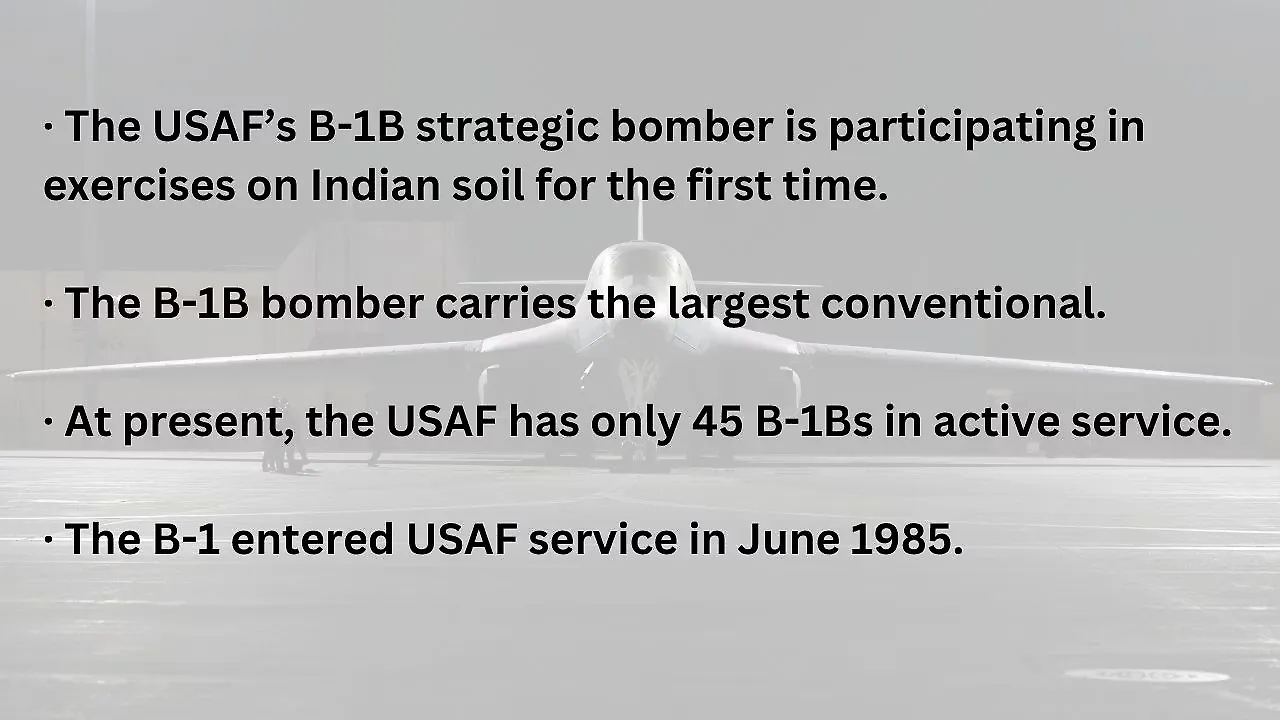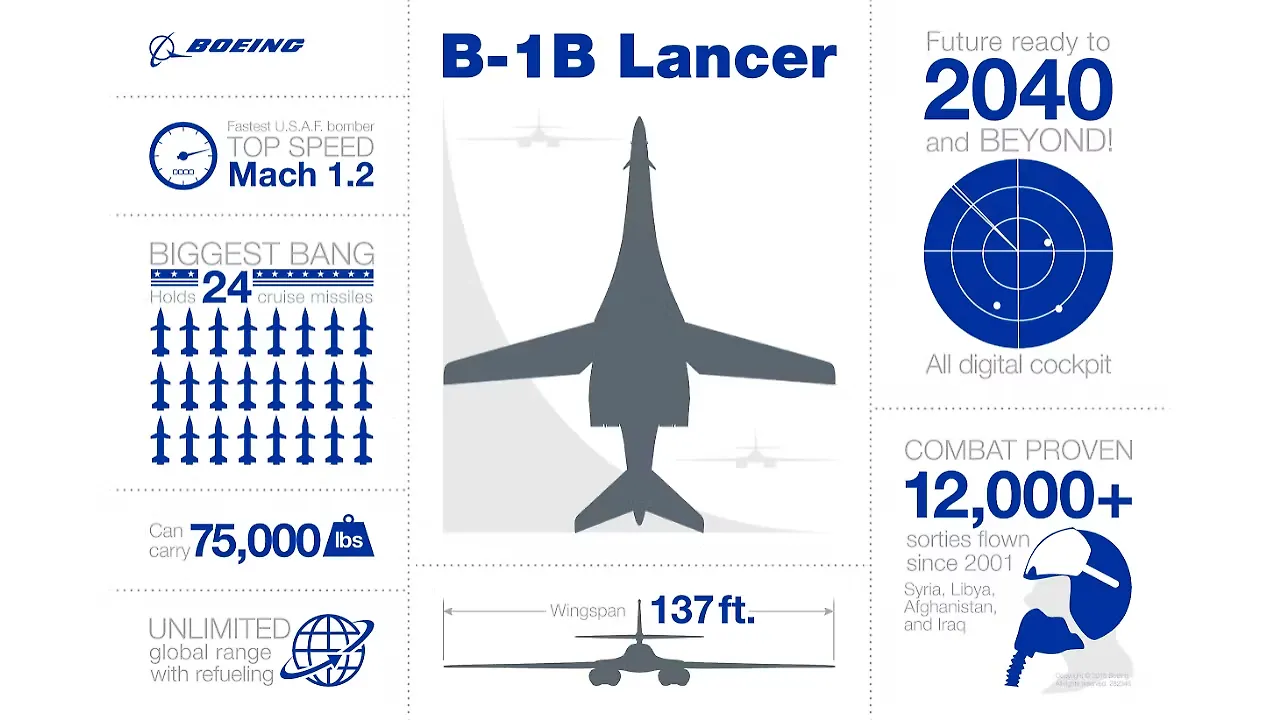
The ongoing Cope India 23 bilateral air exercises between the Indian Air Force (IAF) and the United States Air Force (USAF) witnessed historic participation of the latter’s sleek B-1B Lancer strategic bomber. The bomber carries the largest conventional payload of guided and unguided weapons in the USAF inventory and is the backbone of its long-range bomber force. This is the first time the strategic bomber, which belongs to the USAF Global Strike Command, has participated in military exercises at an IAF airbase.
Now underway at Air Force Station Kalaikunda in West Bengal, this year’s event is one of the largest ever, with specific training being undertaken to increase cooperation alongside IAF airmen during the exercise. In addition to the B-1B, the USAF sent F-15 fighter aircraft to the exercises. IAF aircraft participating in the exercise include the Sukhoi Su-30 MKI, Dassault Rafale, HAL Tejas and Sepecat Jaguar fighter aircraft. The exercises aimed to enhance mutual understanding between the two air forces and share their best practices across Air Force Stations Arjan Singh (Panagarh), Kalaikunda and Agra.
Col Biren Oberoi, Cope India 2023 US Exercise Director, said, “Cope India provides a unique opportunity to promote compatibility among our forces and build on our collective strengths to increase our capabilities.'
The recently concluded first phase of the exercises, focussed on air mobility, involved transport aircraft and Special Forces units from both sides. It concluded on 24 April.
Cope India began in 2004 as a fighter training exercise held at Air Station Gwalior, and the second edition was then held in 2018. The exercise has evolved to incorporate subject matter expert exchanges, air mobility training, airdrop training, large-force exercises, and fighter-training exercises.
The B-1B bombers taking part in Cope India 23 are from the USAF’s 28th Bomb Wing, located at Ellsworth Air Force Base in South Dakota, USA. It is one of the two US bases responsible for the operation and maintenance of the Lancer. The B-1B allows the USAF to deliver large quantities of precision and non-precision weapons against any adversary, anywhere in the world, at any time. It transitioned from a nuclear mission to become a conventional bomber in the 1990s and was modified to undertake close air support missions in the past decade. The cost of a single B-1B bomber circa 2016 was $ 317 million, and only 45 remain in service with the USAF.
Potent Performer
The maiden participation of the B-1B in air exercises in India and the publicity it has received have piqued public interest in the bomber. Only a handful of nations, such as the US, Russia and China, operate large strategic bombers, and only the USAF has a stealth bomber in service in the B-2. Despite its age, the sleek B-1B's blended wing/body configuration and variable-geometry wings give it a deadly appearance that is more than matched by its performance. It holds nearly 50 world records for speed, payload, range, and climb time in its class. The Russian Tupolev Tu-160 ‘Blackjack’ and Tu-22 M3 ‘Blinder’ are the only other swing-wing bomber in service today.

The Lancer’s four General Electric F101-GE-102 afterburning turbofan engines, deliver more than 30,000 Ibs of thrust per engine and allow the bomber, which has a crew of four and a Maximum Takeoff Weight of 216 tonne, to attain a speed of Mach 1.2. Its swing wings are brought to their forward wing settings for takeoff, landing, air refuelling and during some high-altitude weapons employment scenarios. The wings are swept backwards during high subsonic and supersonic flight, enhancing its manoeuvrability in low- and high-altitude regimes. Despite its size, the B-1B’s speed and agility allow it to stay ahead of modern threats.
The B-1B can carry 120 tonne of fuel and 34 tonne of bombs comprised of 84 250 kg Mk-82 or 24 1,000 kg Mk-84 general purpose bombs; up to 84 250 kg Mk-62 or eight 1,000 kg Mk-65 Quick Strike naval mines; 30 cluster munitions (CBU-87, -89, -97) or 30 Wind-Corrected Munitions Dispensers (CBU-103, -104, -105); up to 24 1,000 kg GBU-31 or 15 250 kg GBU-38 Joint Direct Attack Munitions; up to 24 AGM-158A Joint Air-to-Surface Standoff Missiles; 15 GBU-54 Laser Joint Direct Attack Munitions.
Long History
The first B-1A was delivered to the USAF in June 1985, but it was originally conceived in the 1970s as a replacement for the USAF’s B-52 bomber (which is still in service).
The initial design by Rockwell International (which was later acquired by Boeing) was aimed at developing a long-range, high-speed (Mach 2.2) strategic bomber that could overcome the erstwhile Soviet Union’s Surface to Air Missile (SAM) systems. With its swing-wing design, the B-1 could use shorter runways, carry twice the payload, and have a smaller radar profile than the B-52. The first prototype B-1 rolled out of Palmdale, California in October 1974 and a total of four prototypes were built before the programme was cancelled by US President Jimmy Carter in 1977.
The B-1 again found favour with President Ronald Reagan, who in 1981 approved the construction of 100 bombers. The follow-on B-1B was an improved variant initiated in 1981 and resulted in an aircraft with a larger payload of 37 tonne and a drastically reduced radar cross-section, which made it less susceptible to adversary SAM systems. All these changes, however, resulted in the aircraft’s top speed being reduced to Mach 1.2. The first production, B-1, flew in October 1984, and the last B-1B to be built was delivered to the USAF in May 1988.

From 1994, the USAF operated the B-1B as a conventional bomber and it has been extensively used in nearly all combat operations involving US forces since it entered service. In 2015, Boeing began upgrades to the USAF’s B-1B fleet, which included installing all-digital cockpit displays and connecting the bombers to the USAF’s global communications network, in addition to installing Boeing’s integrated battle station. In September 2021, the USAF withdrew 17 B-1B bombers from service, following which the aircraft were placed in storage at Davis-Monthan Air Force Base, Arizona. These aircraft were retired from service, as retaining them would have resulted in short-term costs of $10-30 million dollars per aircraft.
The USAF presently operates three strategic bombers in the B-2 stealth bomber, B-1B and B-52. In the latter half of this decade, this will reduce to two aircraft – the new B-21 stealth bomber and rebuilt B-52s. The B-21 Rader is slated to replace the B-1B and B-2 in 2028.
Also Read